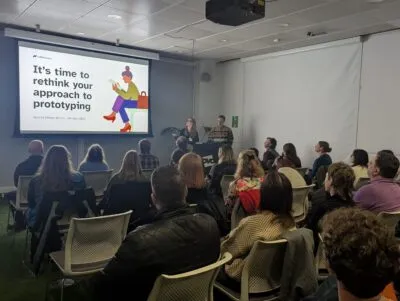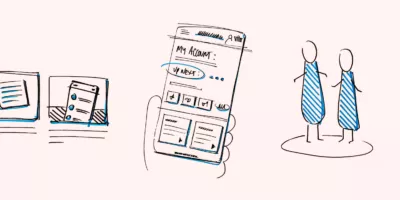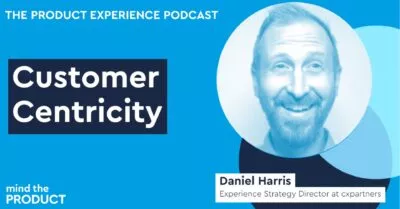22 Jan 2025
The Future of Customer Centricity

As organisations face unprecedented change, Tom Scott (Experience Director) and Stuart Tayler (Strategy Director) from Sopra Steria Next explored how customer-centric practices must evolve to meet tomorrow’s challenges. Their insights from our final week of Customer Centricity Month 2024 reveal why traditional approaches may no longer be enough.
-
Lauren Howells
Marketing Director
Lauren Howells
In our final talk for Customer Centricity Month 2024, Tom Scott explored what the future of customer centricity looks like.
At its heart, customer centricity means putting customer needs at the centre of business decisions. Over two decades, this approach has transformed how organisations work, introducing practices like discovery research, testing with real users, and delivering improvements iteratively. These methods are now common in many organisations.
Yet as we look to the future, organisations face significant challenges that threaten to make traditional customer-centric approaches less effective just when they’re needed most. While specialist teams can create excellent customer experiences, their successes often stay limited to small parts of the organisation. The deeper organisational changes needed for true customer centricity rarely follow.
The rise of Artificial Intelligence (AI) brings new urgency to these challenges. While employees are already using AI tools widely in their daily work – often without visibility or guidance – organisations themselves are still trying to understand what AI means for their future. At the same time, AI promises to dramatically accelerate product development and reduce dependency on specialist teams. This creates a fundamental challenge for current customer-centric practices, which risk being excluded from increasingly automated development processes.
This matters more than ever because we’re already seeing how autonomous technologies can create unintended consequences for people. Unless we find new ways to embed customer research and human-centred development within these accelerated processes, these negative impacts will only increase.
Three priorities for the future
To navigate these challenges and the future of customer centricity, three key themes emerge:
Embedding customer centricity more deeply
Success is no longer just about designing better websites or apps. Instead, we need to help everyone in our organisations understand and serve customers better. This means empowering others to apply the same principles we have for many years, within their own specialist domains and operations. And it means creating value-chains that are customer-centric from top-to-bottom.
Keeping pace with change
As technology evolves rapidly, we need to become skilled partners with AI tools, understanding both their possibilities and their limits. This means learning about the material properties of the technology far more deeply. And it means using these new technologies to do what we do far more efficiently and at far greater scale.
Speculating on future scenarios
We need to get better at imagining and exploring potential futures. This means using design techniques such as Speculative Design, to show what tomorrow might look like, helping organisations spot both opportunities and risks before they become real.
What tomorrow’s organisations need to do
The organisations that thrive in the future will work differently from today. Success will depend on a deeper kind of customer centricity that shapes how the whole organisation thinks and works.
First, they’ll move beyond having specialist teams responsible for customer experience. Instead, understanding and serving customers well will be woven into everyday work across the organisation. Everyone, from finance teams to technology teams, will understand how their decisions affect customers’ lives.
Getting started
Organisations can begin this journey today by:
- Training teams across different departments and roles in basic customer centricity skills and techniques
- Creating to conditions to run many rapid, safe-to-fail experiments with AI to understand it’s potential, it’s limitations and potential consequences.
- Starting speculative design initiatives, helped by today’s GenAI tools, to bring potential future scenarios to life.
To enable this, these organisations will help all employees learn customer-centric skills. Running research sessions, analysing customer feedback, testing prototypes and designing better services will be common skills – as natural as using spreadsheets or giving presentations are today.
Secondly, as AI and associated technologies dramatically speed up how quickly organisations can build and release software, customer-centric practices will need to evolve to stay relevant. When changes can be made and released in minutes rather than months, we’ll need new methods and tools to ensure customer needs and safety still have a role. Traditional approaches to research, testing and design will need to be reinvented for this faster-paced world.
Finally, successful organisations will become skilled at exploring future scenarios and understanding their consequences before they become reality. This forward-looking approach will help them spot both opportunities and risks early, helping ensure change truly benefits customers.
At CX Partners, we’re already putting these principles into practice, both in our own work and in how we help organisations adapt.
Our teams are already:
- Helping clients spread customer-centric skills across their organisation and throughout their value-chains.
- Exploring new opportunities, methods and tools enabled by AI, while carefully considering the human and ethical implications.
- Working with organisations to imagine and prepare for different possible tomorrows.
If you’d like to learn more about how we could help your organisation prepare for these changes, get in touch with our team today. Contact | CXPartners
If you missed this talk, you can watch ‘The Future of Customer Centricity’ on our YouTube Channel as part of our Customer Centricity Month 2024 playlist, where you can also watch the rest of the talks from the event.
Learn more about The Future of Customer Centricity








































